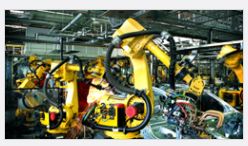
Machine Learning and Mathematica Optimize Automated Assembly Lines
Challenge
Optimize automated assembly-line production processes.
Solution
Use machine learning framework and Mathematica to create adaptive models from data provided by the shop-floor monitoring system.
Benefits
The Mathematica Edge
"The power of Mathematica as a comprehensive platform is still underestimated. The hybrid system lets us easily program complex tasks, solve for results, and seamlessly link to other environments."
Increasingly, our most essential products—such as cars, electronics, and home and work furnishings—are made by automated processes. It is impossible to reset these complex systems without the right decision support or automated recovery. Determining this critical information calls for machine learning.
Enabling Machines to Improve Their Processes
The Mathematica application machine learning framework (MLF) by developer uni software plus is an innovative solution for these systems. MLF enables machines to improve their own processes based on analysis of past event data and other statistics, and helps to create models that are both understandable and computationally fast paced.
MLF is an integral part of production systems for major manufacturers who rely on its data mining and modeling capabilities. Companies such as AMS Engineering—a system provider for highly automated assembly lines that counts Bosch, Braun, and Moeller among its dedicated customers—use MLF to improve overall equipment efficiency and manufacturing processes.
Optimizing Assembly Lines
A given assembly line can easily involve more than 30 processing modules with hundreds of parameters, which change with each frequent product redesign. Mathematica's comprehensive descriptors and solvers combine with MLF's fast model creators and evaluators, accounting for factors such as the product design, equipment availability, production efficiency, and quality rate to continually improve machine "intelligence."
Mathematica and MLF are used throughout the automated assembly process, from creating and testing the right models offline to being an integral part of the shop-floor management systems during production. "The power of Mathematica as a comprehensive platform is still underestimated," says Herbert Exner, president of uni software plus."The hybrid system lets us easily program complex tasks, solve for results, and seamlessly link to other environments. This is how we have designed machine learning framework."
© Copyright 2000-2025 COGITO SOFTWARE CO.,LTD. All rights reserved